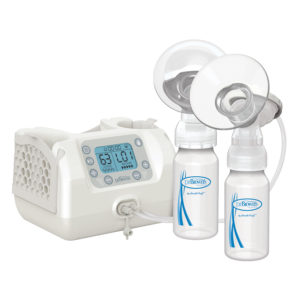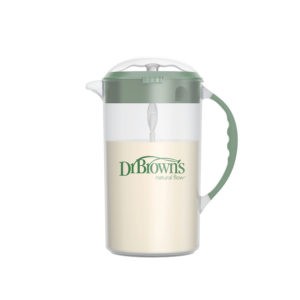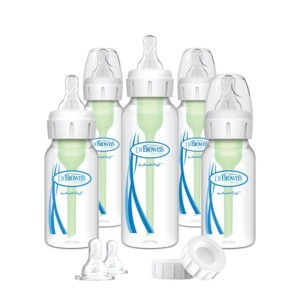Triple feeding and combo feeding are two options that many parents choose to help incorporate both bottles and breastfeeding in baby’s feeding journey.
To start with, triple feeding is when you feed baby at the breast, pump and then offer pumped breastmilk or formula to top off baby. This is used as an option to help maintain milk supply if you are seeing a stark reduction. When feeding baby by bottle, be sure to give them enough ounces until they show signs of fullness. When using the triple feeding method, one option is to feed baby on one breast and use a hand pump or electric pump to pump the other side. This can save time in the feeding process. Another option is to feed baby on both breasts and then pump both breasts when they are finished eating.
Though these methods can seem exhausting and time consuming, either can be a great option to build supply and nourish baby while continuing to breastfeed. Though these feeding options won’t last forever, it’s still important to have a good support system. This team will look like a lactation consultant and a partner or other caregiver who can help you bottle feed baby, clean pump parts, or do diaper changes, as you may need additional help during this time-consuming process so you can be supported and get rest when needed.
Combo feeding is when you feed your baby both breast milk and infant formula. Combo feeding without pumping is a great option if your breastmilk supply is adequate, the baby’s latch is good, and although you don’t want to pump, baby is not feeling completely satisfied after feeds. In this method, you may see a slight reduction in breastmilk production, but you will continue to produce milk.
Here are some options to make combo feeding happen:
- Breastfeed when at home with baby and feed baby, use formula when you are at work
- Bottle feed baby with formula most of the time but breastfeed baby to sleep or at certain times
- Mix in 2-3 bottles of formula in between breastfeeding sessions
Depending on your production of breastmilk, time, and resources, you can choose to give baby any combination of breastmilk and formula as long as baby is gaining weight and it works for you.
A few tips on combo feeding and pumping:
- Try feeding baby a bottle with both breastmilk and formula. This combo can help your breastmilk supply last longer. There is no perfect ratio here—it’s all about how much milk you can produce. You may need to do a little math to see how much milk you regularly pump, how much baby eats at each feeding, and then add the difference in formula to each bottle.
- If utilizing combo feeding with one bottle, make sure to mix the formula first (the water and powdered formula) and then add breastmilk.
How will you know how much milk to give when combo feeding? It’s all about finding your baby’s happy spot. There are fancy calculations you can try, but I recommend feeding on demand. You can start by making a bottle with 1-2 ounces of milk and then adding to it as needed based on their hunger and fullness cues. As baby grows, the volume of milk they will need increases. If you are feeding baby at the breast and supplementing, the amount they drink via bottle could vary at each feed; sometimes they may take several ounces and other times just a little, depending on how much they got from the breast. I usually recommend not feeding for more than 30 minutes total at the breast to practice the latch and promote milk production before supplementing. Any longer than 30 minutes can tire the baby out.
There are many ways to feed your baby. Whether you feed via breastfeeding, pumped milk in a bottle, formula, or any combination of the three, fed is best. Look for baby’s cues to ensure they are satiated and talk with your pediatrician to ensure proper weight gain.
About the author:
Dr. Mona Amin, Pediatrician.

Dr. Mona Amin is a Board Certified General Pediatrician, Parenting expert, and mother.
She has been featured on Parents.com, Romper, CondeNast Traveler, VeryWell Family, NBC News, and was named one of Insider’s Top Pediatricians to follow on social media for 2020. She works in private practice and her passions include: early childhood development, focusing on the impact of healthy sleep, a healthy relationship with food, and healthy coping skills in the first five years of a child’s life.
On her Instagram account (@pedsdoctalk), her podcast (The Pedsdoctalk Podcast), and YouTube channel (Pedsdoctalk TV), she shares educational information on parent’s most common concerns (i.e. fevers, rashes, viruses, behavioral issues, etc.) including current events. Her brand, Pedsdoctalk, has a goal to provide relatable and easy-to-digest education for the modern parent regarding the health and wellness of their child.



